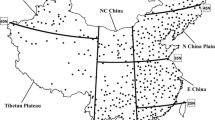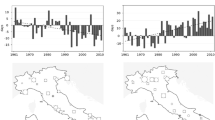Abstract
Changes in Chinese temperature extremes are presented based on a six-hourly surface air temperature dataset for the period 1961–2005. These temperature series are manually observed at 0200, 0800, 1400, and 2000 Beijing Time (LST), and percentile based extreme indices of these time series are chosen for analysis. Although there is a difference in time among the different time zones across China, as more than 80% of the stations are located in two adjacent time zones, these indices for all the stations are called warm (cold) nights (0200 LST), warm (cold) mornings (0800 LST), warm (cold) days (1400 LST), and warm (cold) evenings (2000 LST), respectively for convenience. The frequency of the annual warm extremes has generally increased, while the frequency of the annual cold extremes has decreased, and significant changes are mainly observed in northern China, the Tibetan Plateau, and the southernmost part of China. Based on the national average, annual warm (cold) nights increase (decrease) at a rate of 5.66 (−5.92) d (10 yr)−1, annual warm (cold) days increase (decrease) at a rate of 3.97 (−2.98) d (10 yr)−1, and the trends for the annual warm (cold) mornings and evenings are 4.35 (−4.96) and 5.95 (−4.35) d (10 yr)−1, respectively. For China as a whole, the increasing rates for the occurrence of seasonal warm extremes are larger in the nighttime (0200, 2000 LST) than these in the daytime (0800, 1400 LST), the maximal increase occurs at 2000 LST except in the summer and the minimal increase occurs at 1400 LST except in autumn; the maximal decrease in the occurrence of seasonal cold extremes occurs at 0200 LST and the minimal decrease occurs at 1400 LST.
Similar content being viewed by others
References
Alexander, L. V., and Coauthors, 2006: Global observed changes in daily climate extremes of temperature and precipitation. J. Geophys. Res., 111, D05109, doi: 10.1029/2005JD006290.
Ding, Y. H., and X. S. Dai, 1994: Temperature variation in China during the last 100 years. Meteorological Monthly, 20(12), 19–26. (in Chinese)
Frich, P., and Coauthors, 2002: Observed coherent changes in climatic extremes during the second half of the twentieth century. Climate Research, 19, 193–212.
Gao, X., and Coauthors, 2007: Climate impacts simulations of contemporary land-use change in China. Science in China, 37(3), 397–404. (in Chinese)
IPCC, 2007: Climate Change 2007: The Physical Science Basis. Contribution of Working Group I to the Fourth Assessment Report of the Intergovernmental Panel on Climate Change, Susan Solomon et al., Eds., Cambridge Univ. Press, Cambridge, United Kingdom and New York, NY, USA, 996pp.
Kiktev, D., D. M. H. Sexton, L. Alexander, and K. F., Chris, 2003: Comparison of modeled and observed trends in indices of daily climate extremes. J. Climate, 16, 3560–3570.
Klein Tank, A. M. G., and G. P. Können, 2003: Trends in indices of daily temperature and precipitation extremes in europe, 1946–99. J. Climate, 16, 3665–3680.
Li, J., R. Yu, T. Zhou, and B. Wang, 2005: Why is there an early spring cooling shift downstream of the Tibetan Plateau? J. Climate, 18 (22), 4660–4668.
Mearns, L. O., R. W. Katz, and S. H. Schneider, 1984: Extreme high temperature events: Changes in their probabilities with changes in mean temperature. J. Climate Appl. Meteor., 23, 1601–1613.
Meehl, G. A., and Coauthors, 2000: An introduction to trends in extreme weather and climate events: Observations, socioeconomic impacts, terrestrial cological impacts, and model projections. Bull. Amer. Meteor. Soc., 81(3), 413–416.
New, M., and Coauthors, 2006: Evidence of trends in daily climate extremes over southern and west Africa. J. Geophys. Res., 111, D14102, doi: 10.1029/2005JD006289.
Peterson, T. C., X. Zhang, M. Brunet-India, and J. L. Vázquez-Aguirre, 2008: Changes in North American extremes derived from daily weather data. J. Geophys. Res., 113, D07113, doi: 10.1029/2007JD009453.
Qian, W., and X. Lin, 2004: Regional trends in recent temperature indices in China. Climate Research, 27, 119–134.
Ren, F. M., and P. M. Zhai, 1998: Study on changes of China extreme temperatures during 1951–1990. Chinese J. Atmos. Sci., 22(2), 217–227. (in Chinese)
Ren, G., M. Xu, Z. Chu, and J. Guo, 2005: Changes of surface air temperature in China during 1951–2004. Climatic and Environmental Research, 10(4), 717–727. (in Chinese)
Sen, P. K., 1968: Estimates of the regression coefficient based on Kendall’s tau. Journal of the American Statistical Association, 63, 1379–1389.
Vincent, L. A., and Coauthors, 2005: Observed trends in indices of daily temperature extremes in south america 1960–2000. J. Climate, 18, 5011–5023.
Vincent, L. A., and É. Mekis, 2006: Changes in daily and extreme temperature and precipitation indices for Canada over the twentieth century. Atmos.-Ocean, 44(2), 177–193.
Vincent, L. A., X. Zhang, B. R. Bonsal, and W. D. Hogg, 2002: Homogenization of daily temperatures over Canada. J. Climate, 15, 1322–1334.
Wang, X. L., 2008a: Penalized maximal F-test for detecting undocumented mean-shifts without trendchange. J. Atmos. Oceanic Technol., 25(3), 368–384.
Wang, X. L., 2008b: Accounting for autocorrelation in detecting mean-shifts in climate data series using the penalized maximal t or F-test. J. Appl. Meteor. Climatol., 47(9), 2423–2444.
Wang, X. L., Q. H. Wen and Y. Wu, 2007: Penalized maximal t-test for detecting undocumented mean change in climate data series. J. Appl. Meteor. Climatol., 46(6), 916–931.
Xiang, L. Y., and X. Chen, 2006: Regional and seasonal features of abrupt temperature change in China in recent 55 years. Meteorological Monthly, 32(6), 44–47. (in Chinese)
Zhai, P. M., and X. Pan, 2003a: Change in extreme temperature and precipitation over northern China during the second half the 20th century. Acta Geographica Sinica, 58, 1–10. (in Chinese)
Zhai, P. M., and X. Pan, 2003b: Trends in temperature extremes during 1951–1999 in China. Geophys. Res. Lett., 30(17), 1913.
Zhai, P. M. and Coauthors, 1999: Changes of climate extremes in China. Climatic Change, 42, 203–218.
Zhang, X., and Coauthors, 2005a: Trends in Middle east climate extreme indices from 1950 to 2003. J. Geophys. Res., 110, D22104, doi: 10.1029/2005JD006181.
Zhang, X., L. A. Vincent, W. D. Hogg, and A. Niitsoo, 2000: Temperature and precipitation trends in Canada during the 20th century. Atmos.-Ocean, 38, 395–429.
Zhang, X., G. Hegerl, F. W. Zwiers, and J. Kenyon, 2005b: Avoiding inhomogeneity in percentile-based indices of temperature extremes. J. Climate, 18, 1641–1651.
Zhou, Y. X., and H. B. Yu, 2004: Reconstructing city population size hierarchy of China based on the fifth census (II). City Planning Review, 8, 33–42. (in Chinese)
Author information
Authors and Affiliations
Corresponding author
Rights and permissions
About this article
Cite this article
Hu, Y., He, Y. & Dong, W. Changes in temperature extremes based on a 6-hourly dataset in China from 1961–2005. Adv. Atmos. Sci. 26, 1215–1225 (2009). https://doi.org/10.1007/s00376-009-8140-5
Received:
Revised:
Published:
Issue Date:
DOI: https://doi.org/10.1007/s00376-009-8140-5




